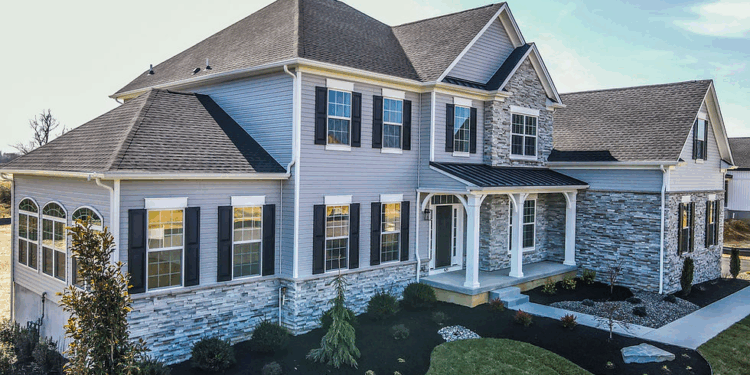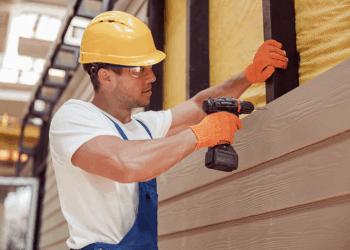
Embark on a journey through the world of lifetime roofing and siding with this captivating introduction. Discover the essence of longevity and durability as we delve into the realm of innovative building materials for your property.
Uncover the secrets behind the superior quality and lasting benefits that come with choosing lifetime roofing and siding, setting a new standard for architectural excellence.
Introduction to Lifetime Roofing and Siding
Lifetime roofing and siding are durable, long-lasting options that offer numerous benefits to property owners. These materials are designed to withstand the elements and provide a high level of protection for your home or building.
Benefits of Choosing Lifetime Roofing and Siding
- Increased durability: Lifetime roofing and siding are built to last, offering superior protection against harsh weather conditions such as rain, wind, and snow.
- Low maintenance: These materials require minimal upkeep, saving you time and money on repairs and replacements.
- Energy efficiency: Lifetime roofing and siding can help improve the energy efficiency of your property, reducing heating and cooling costs.
- Enhanced curb appeal: With a wide range of styles and colors available, lifetime roofing and siding can enhance the overall look of your property.
Comparing Durability
Lifetime roofing and siding are known for their exceptional durability compared to traditional options. These materials are often made from high-quality materials that are designed to withstand wear and tear over time. In contrast, traditional roofing and siding materials may need to be replaced more frequently due to damage from the elements or general wear and tear.
Types of Lifetime Roofing
When it comes to lifetime roofing, there are several types of materials that are commonly used. Each type of material has its own characteristics and suitability for different climates or architectural styles.
Asphalt Shingles
- Asphalt shingles are the most popular choice for roofing in the United States.
- They are affordable, easy to install, and come in a variety of colors.
- Asphalt shingles are durable and can withstand harsh weather conditions.
- They are suitable for a wide range of architectural styles.
Metal Roofing
- Metal roofing is known for its longevity and durability.
- It is resistant to fire, mildew, insects, and rot.
- Metal roofing is lightweight and can reflect heat, making it energy-efficient.
- It is ideal for areas with high winds or heavy snowfall.
Wood Shakes
- Wood shakes provide a natural, rustic look to a home.
- They are eco-friendly and biodegradable.
- Wood shakes are best suited for dry climates and require regular maintenance.
- They are commonly used in traditional or cottage-style homes.
Clay Tiles
- Clay tiles are known for their durability and aesthetic appeal.
- They are fire-resistant and can last for decades.
- Clay tiles are suitable for hot and dry climates.
- They are commonly seen in Mediterranean or Spanish-style architecture.
Siding Options for Lifetime Siding
When it comes to choosing siding options for lifetime siding, there are several materials to consider. Each material comes with its own maintenance requirements, impact on energy efficiency, and insulation properties. Let's explore some of the common siding options available:
Vinyl Siding
Vinyl siding is a popular choice due to its affordability, low maintenance, and durability. It comes in a variety of colors and styles, making it a versatile option for homeowners. However, it may crack or fade over time and might not offer the best insulation compared to other materials.
Fiber Cement Siding
Fiber cement siding is known for its durability and resistance to fire, moisture, and pests. It requires minimal maintenance and can mimic the look of wood or stucco. While it provides good insulation, it can be more expensive than vinyl siding.
Wood Siding
Wood siding offers a natural and timeless look to a home. It can be painted or stained to match the homeowner's preference. However, wood siding requires regular maintenance such as painting, staining, and sealing to protect it from moisture and pests.
Metal Siding
Metal siding is a durable and low-maintenance option that can last for many years. It is resistant to fire, rot, and pests. While it may not offer the best insulation, it is a good option for those looking for a modern and sleek aesthetic.
Impact on Energy Efficiency and Insulation
The choice of siding material can have a significant impact on the energy efficiency and insulation of a building
Each material has its benefits and drawbacks, so weigh your options carefully before making a decision.
Installation Process
Installing lifetime roofing involves several key steps to ensure a durable and long-lasting solution for your home. From preparation to finishing touches, the process requires attention to detail and skilled labor to achieve the best results.
Typical Steps for Installing Lifetime Roofing:
- 1. Inspection and Preparation: The existing roof is inspected for any damage or issues that need to be addressed before installation begins. Prep work may include removing old shingles, repairing the underlying structure, and ensuring proper ventilation.
- 2. Underlayment Installation: A protective underlayment is installed to provide an additional barrier against water infiltration and improve overall roof performance.
- 3. Shingle Installation: Lifetime roofing shingles are carefully installed according to manufacturer guidelines, ensuring proper alignment, fastening, and sealing for optimal protection.
- 4. Flashing and Ventilation: Flashing is installed around roof penetrations and valleys to prevent water leakage, while ventilation systems are added to improve air circulation and extend the life of the roof.
- 5. Final Inspection: Once the roof is fully installed, a final inspection is conducted to ensure quality workmanship and adherence to industry standards.
Tools and Equipment Needed for Installation:
- - Roofing nails and nail gun
- - Shingle cutter and utility knife
- - Ladder or scaffolding for access
- - Roofing hammer and pry bar
- - Underlayment and flashing materials
Common Challenges During Installation:
- - Weather conditions: Rain, wind, or extreme temperatures can impact the installation process and may require adjustments to the timeline.
- - Structural issues: Hidden damage or poor underlying structure can complicate installation and may require additional repairs.
- - Safety concerns: Working at heights and handling heavy materials pose safety risks that need to be managed throughout the installation.
Maintenance and Care
Proper maintenance and care are essential to maximize the lifespan of your lifetime roofing and siding. Regular inspections and timely repairs can help prevent costly damages and ensure the longevity of your investment.
Tips for Maintaining Lifetime Roofing
- Regularly clean debris such as leaves, branches, and dirt from the roof surface to prevent water buildup and potential damage.
- Trim overhanging tree branches to avoid them rubbing against the roof and causing scratches or punctures.
- Check for signs of wear and tear, such as loose or missing shingles, and replace them promptly to prevent further damage.
- Inspect the roof for leaks, especially after heavy storms, and repair any damaged areas to prevent water infiltration.
- Consider applying a protective coating or sealant to enhance the durability of your lifetime roofing.
Importance of Regular Inspections and Repairs
Regular inspections allow you to identify potential issues early on and address them before they escalate into more significant problems. Timely repairs can help maintain the structural integrity of your roofing and siding, prolonging their lifespan and saving you money in the long run.
Preventing Costly Repairs or Replacements
- By investing in routine maintenance and addressing minor issues promptly, you can prevent the need for expensive repairs or full replacements down the line.
- Proper care can extend the life of your roofing and siding, protecting your home and enhancing its curb appeal for years to come.
Cost Considerations
When considering lifetime roofing and siding options, it is important to break down the cost factors associated with these durable materials. While the initial investment may be higher compared to traditional roofing and siding options, there are long-term cost savings to consider.
Initial Investment vs. Traditional Options
- Lifetime roofing and siding materials typically have a higher upfront cost due to their durability and longevity.
- Traditional roofing and siding options may be more affordable initially but may require more frequent repairs and replacements over time.
- It is essential to weigh the initial investment against the long-term benefits of choosing lifetime materials.
Long-Term Cost Savings
- Choosing lifetime roofing and siding can lead to significant cost savings over time as these materials require less maintenance and repair.
- With proper installation and care, lifetime roofing and siding can last for decades, reducing the need for costly replacements.
- Energy-efficient options can also help save on heating and cooling costs in the long run, further adding to the cost savings.
Final Thoughts
As we conclude our exploration of lifetime roofing and siding, remember that investing in quality now can save you from future headaches. Make the smart choice for your property and enjoy a lifetime of protection and style.
Quick FAQs
What are the benefits of choosing lifetime roofing and siding?
Lifetime roofing and siding offer unparalleled durability, longevity, and energy efficiency, providing long-term cost savings and peace of mind for property owners.
How do different types of siding materials impact energy efficiency?
Siding materials play a crucial role in the insulation of a building, affecting its energy efficiency. For example, insulated vinyl siding can significantly improve thermal performance and reduce energy costs.
What are the common challenges faced during the installation of lifetime roofing and siding?
Common challenges during installation include ensuring proper alignment, addressing structural issues, and weather-related delays. Professional installation is key to overcoming these obstacles.












